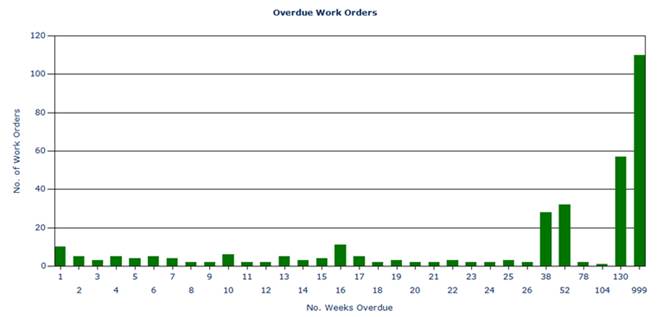Overdue Work Orders
Ref: AG3_204
Description
The report returns a list of work orders that are deemed as overdue based upon selected filter criteria. The report contains 2 sections;
A detailed tabular listing of any work orders meeting the filter criteria
A chart displaying an overdue aging report, showing the quantity of work orders and determined ages


The report returns;
Equipment code
Description (equipment description)
Job Code (Work order number)
Job Description (Work order description)
Status (Job status)
Job Type
Start Date
Due date
WK (Number of weeks overdue)
Craft
Employee (If assigned)
Operational Criteria
The report will return all work orders where the work order due date is less than the date specified in the filter and all other filter criteria are met.
Work Order selection
• Job Type
• Craft
• Due date earlier than
Equipment Selection
• Equipment Filter
If a work order has been worked on by someone or is scheduled to a labour resource then that information is also displayed along with details of the craft required to complete the work order.
The chart operates using the same filter criteria and shows the number of work orders at specific ages.
The chart is broken down into individual weeks up to 26 weeks overdue and then into bands, of 26 weeks (6 months), 38 weeks (9 months), 52 weeks (1 year), 78 weeks (18 months), 104 weeks (2 years). Anything that has been overdue for greater than 2 years is placed into a band labelled 999.
Aims
The report is designed to provide a supervisor or manager details of work orders that are overdue and need addressing. This is to assist in the prioritisation and scheduling of work and help to ensure that nothing is being overlooked.
Results analysis
When looking at the chart as the number of weeks increases the number of overdue work orders should decrease, this indicates that work is being prioritised and addressed.
If large quantities of work orders are overdue n the higher bands then the causes of this this should be investigated by using the detail section to obtain specific work order numbers which can then be examined in the system